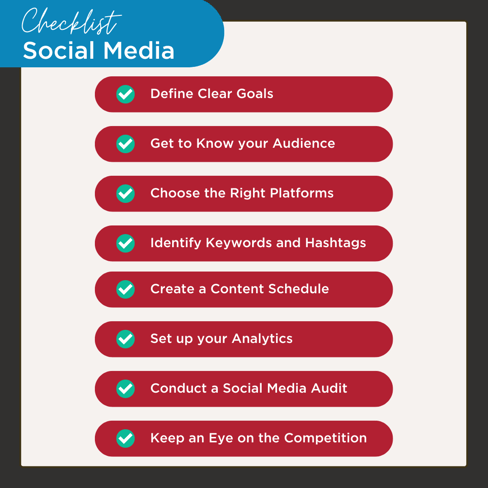Go-To Social Media Checklist
Every marketer should have a go-to checklist for social media marketing. The purpose of a list like this is to help you maintain important foundational pieces of social media marketing, in the ever-changing online world we have today. To build an authentic and engaged audience, here are eight must-haves for your social media strategy.

1. Define Clear Goals
Goals give your social media management a purpose and general direction. A goal is also useful in helping determine your main content themes or pillars. Without any clear goals, your social media presence can appear messy and inconsistent. A key to building an engaged audience is consistency. Without any clear goals, your social media presence can appear messy and inconsistent. Having goals can help you achieve that. Whether you’re just getting started with social media or have been doing it for years, setting goals is a great starting place to reevaluate your strategy.
2. Get to Know Your Audience
Who is your brand speaking to? Maybe your audience is 18 to 24 year-old males living in California. Or perhaps you’re targeting 60+ year-olds across the United States looking for retirement options. Knowing your audience will help you choose content that they really care about and are interested in.
3. Choose the Right Platforms
With Instagram, Facebook, YouTube, Twitter, Pinterest, and so many other social platforms, it can be difficult to choose where to post content. But, fear not! Once you know your audience a bit better, it is easier to determine which social platforms your brand should be on. On top of considering where your audience is present, you should also evaluate if you have the resources to take on a specific platform. For example, TikTok requires a lot of engaging video creation. If that’s not in your team’s wheelhouse, it probably isn’t the best option for you unless you’re able to make a hire and that’s where most of your audience is.
4. Identify Keywords and Hashtags
When we talk about keywords, we usually mean the words your website ranks for. By doing some research, you should be able to find top industry keywords.
Hashtags are commonly used on social media channels. Their purpose is to connect content to a specific topic. Twitter is perhaps the most-known channel for its use of hashtags. Nowadays, hashtags are seen commonly on each social media platform, making it easier to find alike content.
If you want your content to be seen for a specific keyword, you can turn it into a hashtag on your post.
5. Create a Content Schedule
Remember earlier how I said, "Consistency is a key part of social media?" Creating a content posting schedule can help you stay consistent with the number of times you post. Make sure that you account for each social platform your brand is present on! It’s totally normal to give one channel more love than the other, especially if your audience is more active on one, but be consistent across platforms.
On top of scheduling content, you should also determine how much of each pillar content you want to post. Pillar content, or pillars, are commonly referred to as buckets. Each represents subjects that matter to your audience. Some examples of content pillar categories are: inspirational, promotional, educational, and connection/story.
6. Set up Your Analytics
There are a multiple ways you can track your social media analytics. For starters, the social platforms you use have their own analytics section. This is a great starting place to get insights; however a downside to this is not being able to view all social media metrics in one place. If you use a scheduling tool such as HootSuite or Eclincher, you can pull reports directly using these tools and see all of your metrics in one location.
7. Conduct a Social Media Audit
A social media audit is a great way for you to see what’s working, review goals, and look for ways to improve your social presence. We recommend conducting an audit at least once per quarter to get a good pulse on how your social media is performing. If you’re not sure how to conduct your audit, there are plenty of tools you can use such as SEMRush.
8. Keep an Eye on the Competition
Watching what competitors do with their social media can be a useful resource for ideas, but try not to get caught up in what other are doing that you lose sight of your own goals. By following up on a few competitors, you can see what content performed well and what has flopped. SEMRush and other online platforms have competitor analysis tools that allow you to see where your brand is ranking amongst your competitors.
Setting goals, researching your audience and keywords, tracking your performance, and monitoring the competition can be a lot to take on. Contact us to learn how we can help you with any part of your social media strategy!






-1.png)
